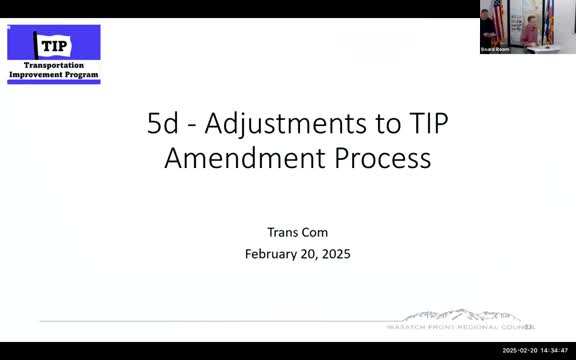Transcom to require written FHWA/FTA conformity confirmations for future TIP modifications
April 27, 2025 | Transportation Coordinating Committee, Wasatch Front Regional Council, Wasatch County Commission and Boards, Wasatch County, Utah
This article was created by AI summarizing key points discussed. AI makes mistakes, so for full details and context, please refer to the video of the full meeting. Please report any errors so we can fix them. Report an error »

The Transportation Coordinating Committee was briefed on procedural changes to the TIP amendment process intended to clarify air‑quality conformity steps and strengthen interagency review.
Wayne Bennion, WFRC staff, told the committee the revisions respond to recommendations from the quadrennial FHWA/FTA certification review and aim to make the process more explicit: for TIP board modifications that could affect an existing conformity determination, WFRC staff will request written confirmation from FHWA and FTA that the current conformity analysis remains valid. The change will also more formally involve the region’s interagency consultation team so federal, state and local air‑quality and planning staff have an explicit opportunity to review proposed TIP changes.
Ben Weatherrich explained staff will add a left‑hand column to future board‑modification tables indicating the “level of conformity analysis” for each request: 1) exempt, 2) funding adjustment only, or 3) requires FHWA/FTA written confirmation that the existing conformity determination remains valid. He showed sample wording and said projects listed as Level 3 will be routed to the interagency team and require formal written concurrence before moves to regional council action.
Why it matters
Conformity determinations are required by federal air‑quality rules to show that transportation plans and programs do not cause emissions to exceed levels in the state implementation plan. Staff said the procedural changes aim to reduce ambiguity and ensure FHWA/FTA and air‑quality partners explicitly sign off when a TIP change could affect emissions assumptions.
Questions and context
Members asked how the new labels would appear in packet materials and whether the change will extend meeting timelines; staff said the table will show the required level and that Level 3 items will require additional interagency consultation and a written FHWA/FTA determination, which could lengthen the process for those projects. Staff emphasized that exempt or funding‑adjustment items (Levels 1–2) will move more quickly while preserving compliance.
Ending
The committee received the proposed process adjustments and staff said the changes were developed in consultation with FHWA, FTA, UDOT and UTA; staff will incorporate the new conformity labels and interagency review step into future TIP board modification materials.
Wayne Bennion, WFRC staff, told the committee the revisions respond to recommendations from the quadrennial FHWA/FTA certification review and aim to make the process more explicit: for TIP board modifications that could affect an existing conformity determination, WFRC staff will request written confirmation from FHWA and FTA that the current conformity analysis remains valid. The change will also more formally involve the region’s interagency consultation team so federal, state and local air‑quality and planning staff have an explicit opportunity to review proposed TIP changes.
Ben Weatherrich explained staff will add a left‑hand column to future board‑modification tables indicating the “level of conformity analysis” for each request: 1) exempt, 2) funding adjustment only, or 3) requires FHWA/FTA written confirmation that the existing conformity determination remains valid. He showed sample wording and said projects listed as Level 3 will be routed to the interagency team and require formal written concurrence before moves to regional council action.
Why it matters
Conformity determinations are required by federal air‑quality rules to show that transportation plans and programs do not cause emissions to exceed levels in the state implementation plan. Staff said the procedural changes aim to reduce ambiguity and ensure FHWA/FTA and air‑quality partners explicitly sign off when a TIP change could affect emissions assumptions.
Questions and context
Members asked how the new labels would appear in packet materials and whether the change will extend meeting timelines; staff said the table will show the required level and that Level 3 items will require additional interagency consultation and a written FHWA/FTA determination, which could lengthen the process for those projects. Staff emphasized that exempt or funding‑adjustment items (Levels 1–2) will move more quickly while preserving compliance.
Ending
The committee received the proposed process adjustments and staff said the changes were developed in consultation with FHWA, FTA, UDOT and UTA; staff will incorporate the new conformity labels and interagency review step into future TIP board modification materials.
View full meeting
This article is based on a recent meeting—watch the full video and explore the complete transcript for deeper insights into the discussion.
View full meeting

